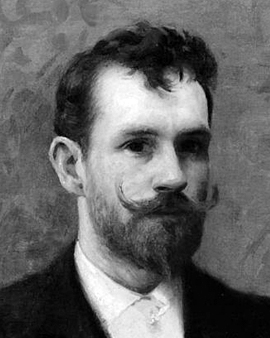


"Only the best die young" - this popular saying has been circulating in artistic circles not only since the era of rock stars. As is well known, this fate has already befallen Wolfgang Amadeus Mozart, Friedrich Schiller - and the Canadian painter Paul Peel: he died of a lung disease at the age of 32 and yet already recognized worldwide. He was born in London (Ontario) in 1860 - his parents' house is now one of the major attractions in Fanshawe Pioneer Village, an open-air museum opened in 1959. He is commonly referred to as an "Academic Painter" - in the English-speaking New World, this is the name given to those artists who orient their style towards the European art academies and therefore tend to paint in a "classical" or "traditional" manner.
In fact, Paul Peel was encouraged to paint by his father and received his training from the Pennsylvania Academy of Fine Arts in Philadelphia - but Peel received his final touches in France, more precisely at the "École des Beaux Arts" and "Academie Julien" schools of applied arts and crafts.William Lees Judson in Philadelphia and Henri Doucet or Jules Joseph Lefebvre in Paris were among his teachers.
Peel exhibited his paintings on both sides of the Atlantic. He was a member of the Royal Canadian Academy of Arts and the Ontario Artists' Association - and with his nudes he brought about a revolution in Victorian-era prudish Canada (officially Canada was still part of Great Britain at the time, and Elizabeth II is still Canada's head of state today). What was already halfway accepted in Europe, especially in France, at that time - namely to publicly show pictures of "naked ice"! - took some getting used to in Canada...
For one of these nude portraits, christened "After the Bath", Peel was awarded the bronze medal at the Paris Salon of 1890 and had thus achieved worldwide fame - at least in specialist circles. However, he was not to enjoy the fame for long: Only two years later, at the age of 32, he was the father of two small children and succumbed to a lung disease - probably tuberculosis, which was feared at the time and for which there was no cure at that time. What remains are over 40 well-known paintings, apart from nudes, above all detailed, colorful nature paintings such as "Lady in the Garden," "Young Botanist," "Young Gleaner" or "Feeding Birds in the Park.

"Only the best die young" - this popular saying has been circulating in artistic circles not only since the era of rock stars. As is well known, this fate has already befallen Wolfgang Amadeus Mozart, Friedrich Schiller - and the Canadian painter Paul Peel: he died of a lung disease at the age of 32 and yet already recognized worldwide. He was born in London (Ontario) in 1860 - his parents' house is now one of the major attractions in Fanshawe Pioneer Village, an open-air museum opened in 1959. He is commonly referred to as an "Academic Painter" - in the English-speaking New World, this is the name given to those artists who orient their style towards the European art academies and therefore tend to paint in a "classical" or "traditional" manner.
In fact, Paul Peel was encouraged to paint by his father and received his training from the Pennsylvania Academy of Fine Arts in Philadelphia - but Peel received his final touches in France, more precisely at the "École des Beaux Arts" and "Academie Julien" schools of applied arts and crafts.William Lees Judson in Philadelphia and Henri Doucet or Jules Joseph Lefebvre in Paris were among his teachers.
Peel exhibited his paintings on both sides of the Atlantic. He was a member of the Royal Canadian Academy of Arts and the Ontario Artists' Association - and with his nudes he brought about a revolution in Victorian-era prudish Canada (officially Canada was still part of Great Britain at the time, and Elizabeth II is still Canada's head of state today). What was already halfway accepted in Europe, especially in France, at that time - namely to publicly show pictures of "naked ice"! - took some getting used to in Canada...
For one of these nude portraits, christened "After the Bath", Peel was awarded the bronze medal at the Paris Salon of 1890 and had thus achieved worldwide fame - at least in specialist circles. However, he was not to enjoy the fame for long: Only two years later, at the age of 32, he was the father of two small children and succumbed to a lung disease - probably tuberculosis, which was feared at the time and for which there was no cure at that time. What remains are over 40 well-known paintings, apart from nudes, above all detailed, colorful nature paintings such as "Lady in the Garden," "Young Botanist," "Young Gleaner" or "Feeding Birds in the Park.
Page 1 / 1








